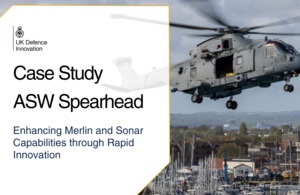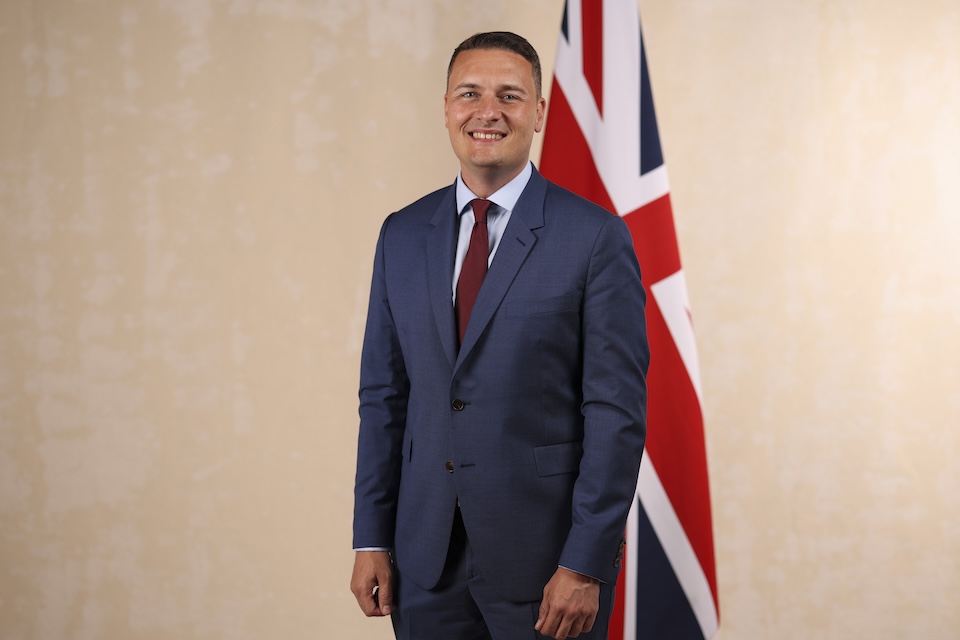- ASW Spearhead has rapidly developed and deployed new technologies to enhance submarine detection capabilities
- Created a 7-step process to quickly and safely upgrade naval technology
- Enhanced Merlin helicopters with improved submarine detection capabilities, reaching operational readiness ahead of schedule
- Implemented sonar interface upgrades to help crews better understand underwater threats
Facing evolving submarine threats, the Royal Navy’s £400 million, seven-year Anti-Submarine Warfare (ASW) Spearhead programme pioneered rapid innovation methods, successfully integrating AI, computing, and autonomous systems to deliver enhanced underwater battlespace awareness for naval commanders.
ASW Spearhead demonstrates the rapid innovation that UK Defence Innovation (UKDI) champions – delivering capabilities faster than traditional methods. The programme’s success stemmed from a 7-step sprint methodology that moved technologies quickly from concept to operational capability.
Speed drives innovation
ASW Spearhead uses a 7-step process with several two-month sprints, moving technologies quickly from concept to capability.
A Military Judgement Panel oversees multiple projects simultaneously, ensuring steady progress and making decisions about which technologies to advance.
The key innovation is connecting requirements, science activities, and capability delivery through one streamlined process with unified funding. This approach enables rapid technology deployment from initial concept to operational use, allowing the military to quickly benefit from emerging technologies
Tristan Butterfield, DE&S Sonar Programme Manager, said “Multi-year funding for the Spearhead programme that links Science & Technology to products has been pivotal to ASW Spearhead’s success. The 7-step process has provided the handrail to guide project activities.”
The Defence Science Technology Laboratory (Dstl) also provided technical support for ASW Spearhead throughout the programme, acting as a cost cutting enabler and sitting on judgement panels to assess capability proposals.
This funding model covered all development activities, giving industry confidence that demonstrators can progress without delays.
Sonar 2087 Rapid Capability Enhancement
ASW Spearhead invested in upgrading Sonar 2087, the main underwater detection system used by Royal Navy anti-submarine ships. Built by Thales, this sonar system helps ships find and track enemy submarines.
The programme developed a new, modern computer interface for Sonar 2087 that makes it easier for operators to see and understand underwater threats. This is a major improvement from the original system designed in 2007. These upgrades are now being installed on ships across the Royal Navy fleet.
Rapid Capability Insertion Platform (RCIP)
Building on the Sonar 2087 upgrades, Spearhead also developed a smart way to test new technology safely called the Rapid Capability Insertion Platform (RCIP).
The RCIP works like a separate testing area that sits outside the main combat systems. This means operators can try new features while keeping the ability to instantly switch back to the original system if needed. This approach lets Royal Navy crews test cutting-edge technology on the front line without any risk to their main operations, while developers can keep improving the systems based on real feedback.
Lieutenant Commander Jonnie Barnes-Yallowley, ASW Spearhead Requirements Manager, explains “The S2087 RCIP has been pivotal to enabling Spearhead to deploy innovative prototype systems from third-party suppliers, providing rapid capability enhancements for the front line.”
Merlin enhacement From Concept to Capability
This rapid approach extended to helicopter upgrades. ASW Spearhead enhanced Merlin helicopters with acoustic systems that can process more sonobuoy channels and combine signals from multiple sources. The enhancement packages for Merlin Mk2 helicopters achieved Initial Operating Capability in March 2024 – demonstrating remarkable speed from concept to deployment.
To help rapidly implement these innovations, a testbed system called THETIS was developed to serve as a sonobuoy emulator, providing realistic training environments while conserving expensive flying hours and sonobuoys.
Not only does THETIS allow crews to familiarise themselves with new capabilities before operational deployment, it also supports early tactics development through trials.
Commander Aidan Riley RN, Commander Merlin Helicopter Force, explains the impact “THETIS at RNAS Culdrose is allowing the Merlin front line to identify and rectify issues within the sonobuoy command and control system, providing accurate and timely fault diagnosis for better system serviceability.”

Trial Mercury Proving Rapid Integration Works
The Spearhead programme achieved breakthrough results through Trial Mercury, where upgraded Sonar 2087 systems and enhanced Merlin helicopters were trialled in late 2023. The trials included Merlin Mk2 helicopters from RNAS Culdrose which operated alongside Type 23 Frigate, HMS Richmond.
These trials represented the first operational use of integrated sensor capabilities, showing how existing platforms could be enhanced at speed, to create networked detection systems.
Engaging Innovation at Scale
Another area of research, Project CHARYBDIS, tackled the challenge of providing persistent, deployable surveillance across vast ocean areas without risking high-value assets. The project employed innovative engagement strategies, including a Market Exploration through Dstl and the Defence and Security Accelerator (DASA).
The Market Exploration received 97 supplier responses, which was DASA’s largest Market Exploration engagement. This approach identified several different concept types and provided foundations for autonomous system development.
Commander Chris Hill MBE RN, ASW Spearhead Programme Director, noted “This novel and exciting approach to exploring and understanding the latest concepts and capabilities in industry has redefined how we engage to address defence’s most challenging problems.”
AI Integration Through PALLAS DAWN
ASW Spearhead ran Exercise PALLAS DAWN to test how artificial intelligence (AI) and machine learning can help find enemy submarines.
For this exercise, military experts created computer systems that could work with different AI tools. They divided the work between military teams and private companies, who worked at the same time on different parts of the project.
The trials created several programmes that give sailors real-time advice during operations
Commander Hill noted “AI/ML offers exciting opportunities but does not provide a single solution, rather a range of capabilities which work together. This modular approach enables the Royal Navy to integrate diverse AI capabilities while maintaining operational flexibility and system reliability.”
Revolutionary Results
The ASW Spearhead programme demonstrates how innovative acquisition approaches can accelerate capability development while maintaining operational assurance. Through Dstl and DASA’s support and Trial Mercury’s success, the programme has established frameworks for continuous innovation, creating capabilities that provide commanders with battlespace advantages.
The programme aligns with UKDI’s mission to accelerate defence technology development and has proven that combining emerging technologies with innovative acquisition practices can deliver rapid capability enhancements, setting new standards for defence innovation.
.jpg?width=1200&height=800&crop=1200:800)






